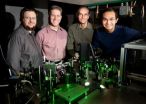(Press-News.org) Fifty-seven laboratories from 29 countries volunteered to put their measuring competence to the test. Each laboratory received a sample without knowing the levels of heavy metals present, and was asked to measure and report the values back to the JRC.
The good results should enhance consumers' confidence, as maximum levels of lead, cadmium and total mercury in seafood are regulated by EU law and it has been proven that most participants are able to correctly measure them. In addition, this comparison has highlighted other issues, such as the apparent dependency of the measurements of inorganic arsenic on the type of food tested.
Excessive intake of heavy metals may lead to a decline in mental, cognitive and physical health. A particular concern is potential developmental defects in children exposed in utero. From a toxicological point of view, the chemical form in which the metal is ingested plays a significant role. For example, methylmercury is much more toxic than inorganic mercury compounds, whilst inorganic arsenic is more toxic than the organic species of arsenic.
The interlaboratory comparison
The interlaboratory comparison was organised in support of the European Co-operation for Accreditation (EA), the Asia Pacific Laboratory Accreditation Cooperation (APLAC) and the national reference laboratories associated to the European Union Reference Laboratory for Heavy Metals in Feed and Food.
Participants were asked to report both the measured value of each heavy metal in question in the sample and the uncertainties associated with those measurements. The results were scored according to international standards .
The outcome of the exercise was generally positive. All of the 57 laboratories that registered reported results. The share of satisfactory scores ranged between 80% and 96% (Table 1 in pdf link). Participants tended to underestimate the content of total arsenic, and to a lesser extent total cadmium. The distribution of the participating laboratories by country is shown in Figure 2 in pdf link.
Contrary to a previous exercise (IMEP-107 on total and inorganic arsenic in rice), the values reported for inorganic arsenic showed a large spread. Interestingly, this indicates that the matrix (in this case, seafood), has a major influence on the analytical determination of inorganic arsenic. This is a crucial consideration for legislators, because specifying single maximum level of arsenic in food would appear to be unfeasible.
Legislative situation
In Europe, maximum levels for lead, cadmium and total mercury in food are laid down in legislation , varying from 0.5 to 1.0 mg. per kg. for different seafood. No maximum level exists for the methylmercury form of mercury, as its measurement requires specific analytical equipment not routinely present in testing laboratories. However, methylmercury is the main source of human intake of mercury in fish and fishery products, and is important due to its high toxicity compared to inorganic mercury.
No maximum levels for arsenic have been laid down in European legislation either, due to a lack of information about reliable analytical methods for determining inorganic arsenic in different food commodities, and measurement values of inorganic arsenic are generally believed to be method-dependent.
The interlaboratory comparison was, therefore, extended to include methylmercury and inorganic arsenic, in order to investigate the issues that laboratories encounter in measuring these substances.
INFORMATION:
JRC-IRMM and the EU Reference Laboratories
The Institute for Reference Materials and Measurements (IRMM) is one of the seven institutes of the Joint Research Centre (JRC) which is a Directorate-General of the European Commission.
It operates four European Union Reference Laboratories (EU-RL), including the EU-RL for heavy metals in feed and food. The EU-RLs are analytical laboratories designated by EU legislation and which are an integral part of European risk management system. Their duties include setting up EU-wide standards for reliable testing methods, organising comparative tests, training analysts from national laboratories and providing scientific and technical assistance to the European Commission.
JRC-IRMM also operates the International Measurement Evaluation Programme (IMEP®). It organises interlaboratory comparisons in support to EU policies. Many of the interlaboratory comparisons are open to all laboratories that wish to participate, but some are restricted to, for example, national reference laboratories. Proficiency tests are normally carried out only on request of another Commission department or agency. Some comparisons are run to certify reference materials and validation studies are organised regularly to validate analysis methods.
Download
Interlaboratory comparison report: "IMEP-30: Total arsenic, cadmium, lead, and mercury, as well as methylmercury and inorganic arsenic in seafood": http://irmm.jrc.ec.europa.eu/news/Documents/IMEP_30_report.pdf
Contacts
Elena Gonzalez Verdesoto, JRC Press officer: elena.gonzalez-verdesoto@ec.europa.eu
David Anderson, JRC-IRMM Communication officer: david.anderson@ec.europa.eu
END
About 30% of breast cancer patients have tumours that show rapid growth and invasion through the body. A common denominator in all of these cases is the presence of a large number of Her2 proteins in tumour cellular membranes. Consequently, these aggressive tumours are referred to as HER2+. Scientists working in the Metastasis Laboratory (MetLab) at IRB Barcelona headed by ICREA researcher Roger Gomis, have described the molecular mechanism that induces HER2+ tumours to ignore the signals that protect cells from excessive growth. The study is published this week in the ...
In the wake of devastating cholera outbreaks in refugee camps in earthquake-wracked Haiti, a group of leading experts from Harvard Medical School, George Washington University, and the International Vaccine Institute (IVI) have urged the United States to create an emergency stockpile of cholera vaccines for future humanitarian use.
"The costs to the U.S. of creating and maintaining a stockpile of several million doses of cholera vaccine would be low," said the experts in an article published online first on November 24 in The New England Journal of Medicine (NEJM). "But ...
A new process for creating a personalized vaccine may become a crucial tool in helping patients with colorectal cancer develop an immune response against their own tumors. This dendritic cell (DC) vaccine, developed at Dartmouth and described in a research paper published this week in the journal Clinical Cancer Research, was used after surgical resection of metastatic tumors to try to prevent the growth of additional metastases.
"The results of the study suggest a new way to approach cancer treatment," said Richard Barth Jr., MD, Chief of General Surgery at Dartmouth-Hitchcock ...
The search is on for insects, mites, microbes or nematodes that could be used in a biologically based approach to controlling silverleaf nightshade, an invasive weed from the Americas that has spread to southern Europe, Africa, India, Australia and elsewhere.
According to U.S. Department of Agriculture (USDA) entomologist Walker Jones, the perennial weed, Solanum elaeagnifolium, is being targeted for its ability to outcompete native plants, reduce crop yields and diminish pasture productivity. Its orange, toxin-producing berries can also poison livestock.
Severe infestations ...
London, UK, 24 November 2010 – Research from the Laboratory of Psychiatry and Experimental Alzheimers Research (http://www2.i-med.ac.at/psychlab/) at the Medical University Innsbruck (Austria) demonstrated that chronic high fat cholesterol diet in rats exhibited pathologies similar to Alzheimer's disease. The results were published in Molecular Cellular Neuroscience (45(4):408-417, 2010) with lead author Dr. Christian Humpel. The study was co-authored by PhD students, Celine Ullrich and Michael Pirchl, from the same Laboratory.
Alzheimer's disease is a severe neurodegenerative ...
Mildew infections not only cause unsightly vegetable patches, they can also result in extensive crop failure. Interestingly, the processes involved in infections with this garden pest are similar to those involved in fertilisation. Scientists from the Max Planck Institute for Plant Breeding Research in Cologne and the University of Zurich have identified two proteins in the model plant species Arabidopsis thaliana that are necessary for both fertilisation and infection with powdery mildew. This explains why mildew-resistant plants, in which these genes are mutated, are ...
Leading experts from the European Society on Clinical and Economic Aspects of Osteoporosis and Osteoarthritis (ESCEO) and the International Osteoporosis Foundation (IOF) have published a timely position paper on the association between subtrochanteric femoral (upper thigh bone) fractures and long-term treatment with bisphosphonates.
Bisphosphonates are the most common drug therapy for osteoporotic fracture prevention, prescribed to millions of people around the world. Concern among doctors and patients has arisen following recent media reports that cite a possible association ...
CAMBRIDGE, Mass. -- In a new study to be published in the Nov. 25 issue of Nature, MIT cancer biologists show that restoring the protein p53's function in mice with lung cancer has no effect early in tumor development, but restoring the function later on could prevent more advanced tumors from spreading throughout the body.
Cancer researchers have known since the 1980s that p53 plays a critical role in protecting cells from becoming cancerous. P53 is defective in about half of all human cancers; when it functions correctly, it appears to suppress tumor formation by preventing ...
CHAMPAIGN, Ill. – The long, anxious wait for biopsy results could soon be over, thanks to a tissue-imaging technique developed at the University of Illinois.
The research team demonstrated the novel microscopy technique, called nonlinear interferometric vibrational imaging (NIVI), on rat breast-cancer cells and tissues. It produced easy-to-read, color-coded images of tissue, outlining clear tumor boundaries, with more than 99 percent confidence – in less than five minutes.
Led by professor and physician Stephen A. Boppart, who holds appointments in electrical and computer ...
MEDFORD/SOMERVILLE, Mass. -- Some of the universe's most massive galaxies may have formed billions of years earlier than current scientific models predict, according to surprising new research led by Tufts University. The findings appear in the Astrophysical Journal published online Nov. 24 in advance of print publication on Dec. 10, 2010.
"We have found a relatively large number of very massive, highly luminous galaxies that existed almost 12 billion years ago when the universe was still very young, about 1.5 billion years old. These results appear to disagree with ...

